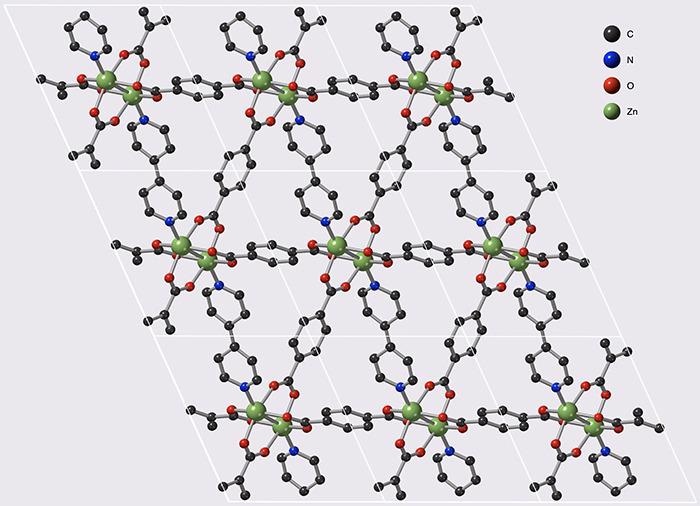Reviewed by Alex SmithApr 22 2022
The CNRS, Air Liquide and the University of Kyoto (Japan) have illustrated the potential capabilities of a new family of materials for storing flammable gases like acetylene.
 Structure of the Metal-Organic Framework MOF-508, composed of carbon (black), nitrogen (blue), oxygen (red), and zinc (green). The flexibility and catenated nature of this framework are key parameters for the storage of acetylene. Image Credit: © François-Xavier Coudert/CNRS.
Structure of the Metal-Organic Framework MOF-508, composed of carbon (black), nitrogen (blue), oxygen (red), and zinc (green). The flexibility and catenated nature of this framework are key parameters for the storage of acetylene. Image Credit: © François-Xavier Coudert/CNRS.
These nanoporous and flexible materials can be modified to enhance small molecule adsorption at the temperatures and pressures required for industrial applications. The observations were published on April 21st, 2022, in the Nature Chemistry journal.
The transport of flammable gases poses significant challenges. These gases must be handled at specific temperatures and pressures to guarantee industrial safety, which prevents optimal storage and release cycles. Existing porous materials can help capture specific gases, but their great affinity for these molecules makes it difficult to release them: a significant amount of gas is trapped in the host material.
Researchers have recently demonstrated the ability of new patented materials to capture and release acetylene, indicating that they may provide a solution. They can contain and release 90 times more acetylene for a given volume. Compared to existing porous materials, 77% of the gas stored in a cylinder can be recovered. All of this takes place at temperatures and pressures suitable for industrial use.
The material belongs to the family of Metal-Organic Frameworks (MOFs), a type of material that forms nanoporous crystal structures. The MOFs investigated in this study have the unique property of being flexible, allowing them to operate in two states: “open” and “closed,” enabling gas storage and release. They can also be modified to finely control the storage–release pressure, making them suitable for a variety of industrial constraints.
The investigators intend to test new modifications based on these findings in an attempt to provide these flexible MOFs with novel properties, such as facilitating the capture of methane, CO2, or hydrogen. To develop industrial applications, lowering the cost of these novel materials remains a major goal.
This study was conducted as part of the SMOLAB International Research Project, which brings together and reinforces complementary French and Japanese strengths in the field of flexible MOFs and applications. SMOLAB was founded by the University of Kyoto and the CNRS in collaboration with Air Liquide, Claude Bernard University Lyon 1 and Chimie ParisTech/PSL University in 2018.
Journal Reference:
Bonneau, M., et al. (2022) Tunable acetylene sorption by flexible catenated metal–organic frameworks. Nature Chemistry. doi.org/10.1038/s41557-022-00928-x.